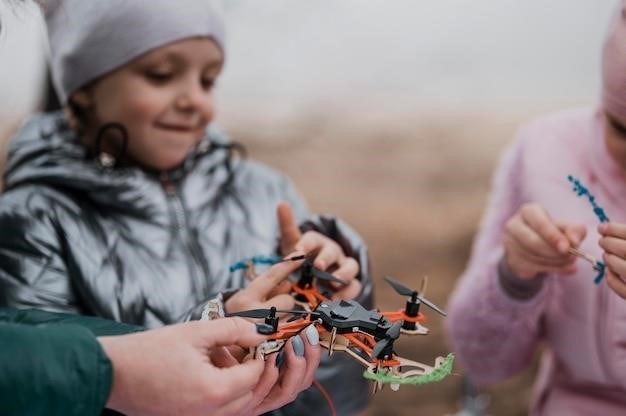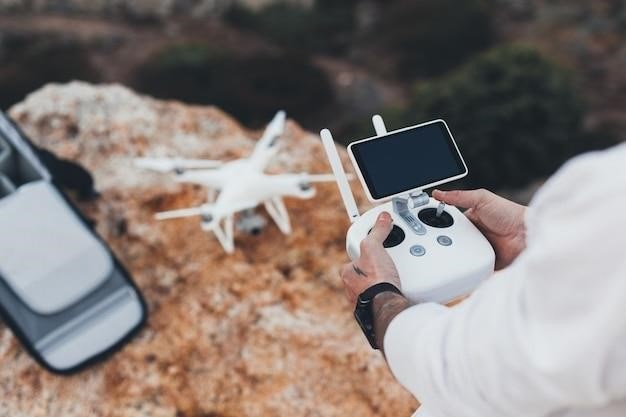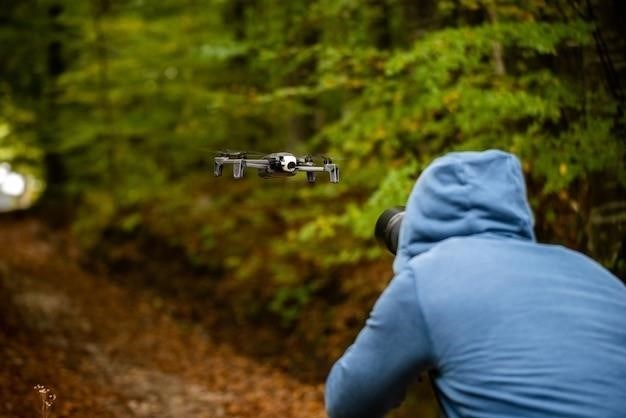
drone survival guide
Drone Survival Guide⁚ A Practical Guide to Spotting and Evading Drones

The world is increasingly filled with drones, and it’s essential to understand how to spot and evade them. This guide provides practical tips and strategies for staying safe in a drone-filled world. It’s not about anti-drone warfare or propaganda but rather about empowering individuals to understand the changing technological landscape and take proactive measures to protect themselves.
Introduction⁚ The Rise of Drones
The rise of drones has been nothing short of meteoric. What were once primarily military tools are now rapidly entering civilian airspace, transforming industries and raising concerns about privacy and security. From package delivery and aerial photography to surveillance and even weaponization, drones are becoming increasingly ubiquitous. This rapid proliferation has sparked a need for greater awareness and understanding of these unmanned aerial vehicles. The Drone Survival Guide aims to equip individuals with the knowledge and skills to navigate this evolving technological landscape, fostering a sense of preparedness and empowerment.
The Federal Aviation Administration (FAA) predicted in 2012 that within 20 years there could be as many as 30,000 drones flying over U.S. soil alone. This prediction underscores the exponential growth of drone technology and the need for proactive measures to address the associated challenges. As robotic birds become commonplace, it’s essential to recognize their presence, understand their capabilities, and be prepared to respond accordingly.
Understanding Drone Types and Capabilities
Drones come in various shapes, sizes, and capabilities, making it crucial to understand the different types you might encounter. While some are designed for recreational purposes, others are equipped for surveillance, data collection, or even carrying payloads. Here’s a breakdown of common drone types and their capabilities⁚
- Consumer Drones⁚ These are typically small, lightweight, and relatively inexpensive drones designed for hobbyists and aerial photography enthusiasts. They often feature cameras for capturing stunning footage but lack the advanced features of larger drones.
- Commercial Drones⁚ These drones are utilized for various professional applications, including inspection, mapping, agriculture, and delivery. They often possess more robust features, such as longer flight times, greater payload capacity, and advanced sensors.
- Military Drones⁚ Designed for military operations, these drones are typically larger, more powerful, and equipped with advanced sensors, weapons systems, and communication capabilities. They serve a wide range of purposes, from reconnaissance and surveillance to targeted strikes.
Being aware of the different types of drones and their capabilities allows you to better assess potential threats and develop appropriate countermeasures.
Identifying Drone Silhouettes⁚ A Visual Guide
Recognizing drone silhouettes is a crucial skill in a world increasingly populated by unmanned aerial vehicles. Just as our ancestors could spot predators by their shapes, understanding the distinct forms of drones can help you stay alert and aware. The Drone Survival Guide, a project by graphic designer Ruben Pater, offers a visual guide that familiarizes individuals with the most common drone silhouettes.
The guide presents a diverse range of drones, from small consumer models to larger military UAVs, each drawn to scale for size comparison. It includes iconic models like the DJI Phantom, the Autel Robotics EVO, and the Yuneec Typhoon, as well as less familiar military drones like the General Atomics MQ-9 Reaper and the Chinese CH-4. By familiarizing yourself with these shapes, you can better identify potential threats and take appropriate actions.
The Drone Survival Guide is available for free online and serves as a valuable tool for anyone seeking to navigate the increasingly drone-filled skies.
Countermeasures⁚ How to Disrupt Drone Operations
While the Drone Survival Guide primarily focuses on awareness and evasion, it also acknowledges the need for countermeasures in certain situations. These countermeasures aim to disrupt drone operations, preventing them from effectively carrying out surveillance or other activities. While some countermeasures require specialized equipment or technical expertise, others are readily accessible and can be employed by ordinary individuals.
One common tactic is to use signal jammers, devices that interfere with the drone’s communication with its operator. These jammers can be purchased online and are relatively inexpensive. Another approach is to use drone-detecting software, which can identify and track nearby drones, alerting users to their presence. Additionally, physical barriers like nets or specialized drone-catching guns can be used to capture or disable drones.
It’s important to note that the legality of using countermeasures varies depending on location and specific circumstances. Always research and comply with local laws before employing any countermeasure.
Protecting Yourself from Surveillance
Drones are increasingly used for surveillance, raising concerns about privacy and security. The Drone Survival Guide addresses these concerns by providing practical tips for protecting yourself from unwanted surveillance. One key strategy is to be aware of your surroundings and identify potential drone activity. This includes looking for unusual sounds, shadows, or movements in the sky, and checking for the presence of drones or their operators.
To minimize your vulnerability, consider limiting your exposure to public spaces where drones are likely to operate. If you’re in an area known for drone activity, try to stay in covered areas or behind barriers that can obstruct drone vision. Additionally, be mindful of your online activity and limit the information you share online that could be used to track your movements or identify your location.
While complete protection from drone surveillance is difficult, understanding the potential risks and taking proactive measures can significantly reduce your vulnerability.

Drone Survival Tactics⁚ Staying Safe in a Drone-Filled World
The Drone Survival Guide emphasizes practical tactics for staying safe in a world increasingly dominated by drones. These tactics go beyond simply spotting and evading drones; they involve understanding how drones operate and utilizing countermeasures to minimize their impact. One key tactic is to disrupt drone operations by interfering with their sensors or communication signals. This can be achieved using various methods, such as using anti-drone jammers or employing reflective materials to create interference.
Another important tactic is to protect yourself from surveillance by minimizing your exposure to drones. This includes being mindful of your surroundings, avoiding areas known for drone activity, and taking steps to obscure your location or movements. The guide also emphasizes the importance of staying informed about drone regulations and developments in drone technology. By staying vigilant and understanding the evolving landscape of drone use, individuals can better protect themselves and adapt to a drone-filled world.
The Future of Drone Technology⁚ Preparing for What’s to Come
The Drone Survival Guide acknowledges that drone technology is constantly evolving, becoming more sophisticated and accessible. This means that the tactics for spotting, evading, and disrupting drones will need to adapt as well. Future drones are expected to be smaller, quieter, and more autonomous, making them even harder to detect. They may also be equipped with advanced sensors and artificial intelligence, allowing them to operate in complex environments and perform tasks with greater efficiency.
To prepare for these future developments, the guide encourages individuals to stay informed about the latest advancements in drone technology. This includes researching new drone models, understanding the capabilities of emerging technologies, and exploring countermeasures that can be used against more advanced drones. The guide also emphasizes the importance of building a knowledge base about drone regulations and ethical considerations surrounding their use, as these factors will continue to shape the future of drone technology.
The Drone Survival Guide⁚ A Call to Action
The Drone Survival Guide is not just a collection of information; it’s a call to action. It urges individuals to become more aware of their surroundings and the potential for drone surveillance. The guide emphasizes the importance of proactive measures, such as understanding drone technology, learning about potential threats, and exploring countermeasures. It’s a reminder that individuals have a role to play in shaping the future of drone technology and ensuring their own privacy and security in a world increasingly dominated by these devices.
The guide encourages individuals to share their knowledge and resources with others, creating a community that is informed and empowered to navigate the complexities of drone technology. By raising awareness, fostering dialogue, and promoting responsible use, the Drone Survival Guide aims to create a future where individuals can coexist with drones in a way that respects privacy, security, and ethical considerations.
Empowering Individuals in a Drone-Dominated World
As drone technology continues to advance, it’s crucial for individuals to be equipped with the knowledge and tools to navigate this evolving landscape. The Drone Survival Guide provides a valuable resource for understanding the capabilities of drones, identifying potential threats, and taking proactive steps to protect oneself. The guide emphasizes that individuals are not powerless in the face of increasing drone use. By embracing a proactive approach, individuals can empower themselves to make informed decisions, safeguard their privacy, and contribute to a future where drone technology is used responsibly and ethically.
The guide’s call to action extends beyond individual preparedness. It highlights the need for collective action, fostering community awareness and promoting responsible drone use. By sharing information, engaging in dialogue, and advocating for responsible regulations, individuals can work together to create a future where drones are used for good, while respecting the privacy and security of all.
Resources⁚ Further Information and Tools
The Drone Survival Guide serves as a starting point for understanding the evolving world of drones, but there are many additional resources available to deepen your knowledge and enhance your preparedness. For those seeking detailed information about specific drone models, their capabilities, and potential countermeasures, online databases like the Drone Survival Guide itself offer valuable insights. Organizations like the Electronic Frontier Foundation (EFF) and the American Civil Liberties Union (ACLU) provide comprehensive resources on privacy rights and surveillance technologies, including drones.
Beyond online resources, consider exploring books and articles by experts in the field of drone technology and privacy. These sources often delve into the ethical and legal implications of drone use, offering a broader perspective on the challenges and opportunities presented by this rapidly advancing technology. Remember, staying informed is the first step towards navigating a world increasingly shaped by drone technology.
About the Author
Ruben Pater, the creator of the Drone Survival Guide, is a Dutch graphic designer with a keen interest in the intersection of technology and society. His work often explores the impact of emerging technologies on our lives, prompting reflection and awareness. Pater’s background in graphic design allows him to communicate complex information in a visually engaging and accessible way, making the Drone Survival Guide a powerful tool for understanding the growing presence of drones in our world.
Driven by a desire to inform and empower individuals, Pater has made the Drone Survival Guide available as a free resource, encouraging its translation and dissemination. His commitment to open access and public awareness has made the guide a valuable tool for people around the globe seeking to understand the evolving landscape of drone technology and its implications for our privacy and security.
Comments (0)